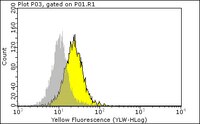Platelet-derived growth factor mimics phorbol diester action on epidermal growth factor receptor phosphorylation at threonine-654.
Davis, R J and Czech, M P
Proc. Natl. Acad. Sci. U.S.A., 82: 4080-4 (1985)
1985
Afficher le résumé
Addition of platelet-derived growth factor (PDGF) to quiescent WI-38 human fetal lung fibroblasts mimics the effect of tumor-promoting phorbol diesters to inhibit the high-affinity binding of 125I-labeled epidermal growth factor (125I-EGF). PDGF, like phorbol diesters, was found to increase the phosphorylation state of EGF receptors immunoprecipitated from intact fibroblasts that were labeled to equilibrium with [32P]phosphate. Phosphoamino acid analysis of the EGF receptors indicated that both PDGF and phorbol diesters increased the level of [32P]phosphoserine and [32P]phosphothreonine. Phosphopeptide mapping of the EGF receptor demonstrated that PDGF increased the phosphorylation of several sites and induced the phosphorylation of a site that was not observed to be phosphorylated on EGF receptors isolated from control cells. This latter phosphorylation site on the EGF receptor was identified as threonine-654, previously shown to be phosphorylated in response to phorbol diesters in intact cells or by purified protein kinase C in vitro. Further, it was observed that PDGF mimicked the action of phorbol diesters to inhibit the EGF-dependent tyrosine phosphorylation of the EGF receptor in [32P]phosphate-labeled fibroblasts. These results are consistent with the hypothesis that increases in diacylglycerol and Ca2+ levels caused by addition of PDGF to fibroblasts activate protein kinase C and that this kinase, at least in part, mediates the effect of PDGF on the phosphorylation of the EGF receptor. The data further suggest that protein kinase C may play an important role in the regulation of cellular metabolism and proliferation by PDGF. | 2987962
 |












